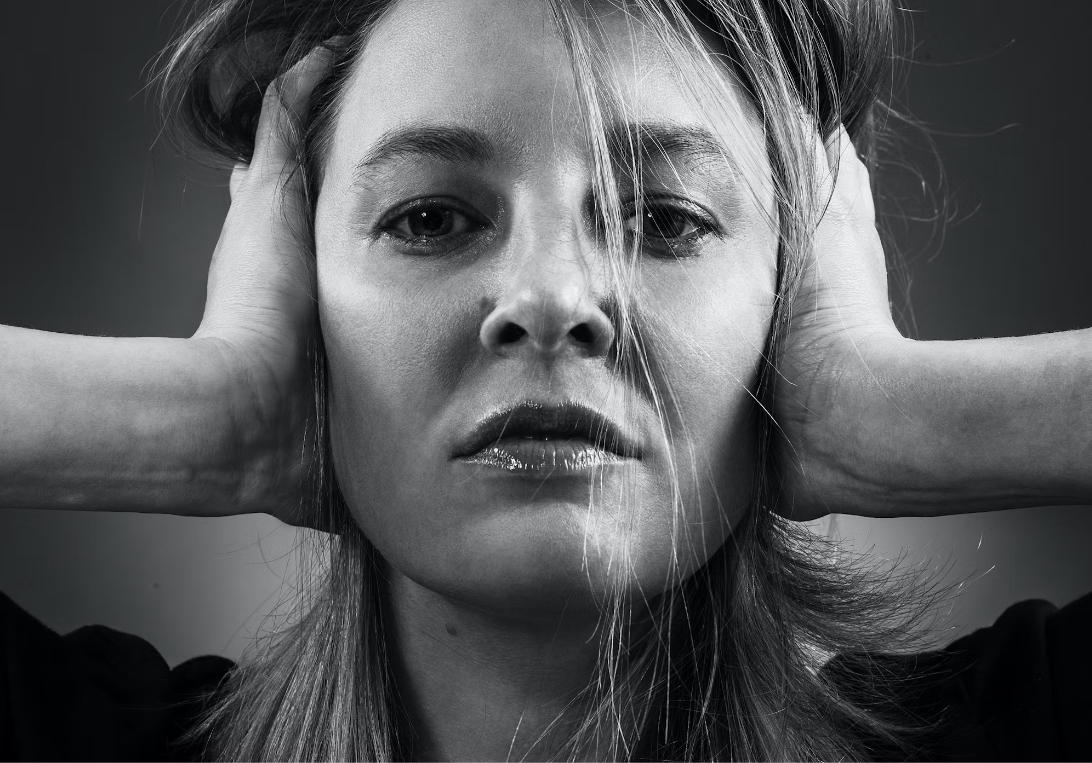We are among the first to enter Q Theatre’s Rangatira. It’s Friday night, and an opening, so most of the attendees have set up camp in the bar downstairs, or at the line of bench tables blooming out onto Queen Street from the theatre frontage. The characteristically-open Rangatira stage has its set pieces on wheels, wooden flats with their backs to us; the wings are exposed, inviting us immediately into the act of construction.
There’s something almost cavernous about the dark unadornment of the stage. It occupies as much space as the raked audience seating, and there’s no demarcation between its ceiling and ours: the lack of a proscenium arch holds us all, involved, together. As other audience members start to join us, the planes and angles remind me of something, some chamber I know well, but can’t quite place.
“Who chooses the music?” my friend asks, of the pre-show playlist. I suggest that it depends, theatre to theatre; on the distribution of resources, on a company’s degree of autonomy, on money, on time. The Rangatira continues to fill with patrons. We see arts administrators unsure of their seats, actors and directors embracing across rows. I realise the chamber I’ve been thinking of is a mouth.
The Writer, written by Ella Hickson and originally staged at London’s Almeida Theatre in 2018, is transplanted into Tāmaki Makaurau well. There are nods to Dominion Road, and a passive-aggressive-and-then-overtly-aggressive kūmara and cassoulet interlude. A poster for Angry Young Woman, the fictional play by the titular Writer, reveals it was staged at Q’s next-door neighbour, the Basement. Likewise, the struggles within the play—of power: personal, political, creative; of convention; of the gaze; of sex—strike home, at times humorous and at others harrowing, almost in the same breath. (There is also a degree of the palimpsest to it all: one cannot help thinking, when discussion turns early on to staging rape, of the graphic handling in Silo’s A Streetcar Named Desire on this same Rangatira stage, this same time of year, back in 2017.)
Sophie Roberts’s direction is slick, thorough and very knowing, in the way that theatre about theatre can afford to be. There are some specific, subtle masterstrokes; the performance register of the opening scene, for example, at first seems to be delivered in earnest, with a kind of stichomythic, Good Theatre Dialogue™ inflection. I settle into that exchange, hearing the audience responding to what we recognise as the theatre industry, and what we have come to recognise within the space as a well-written script. I find myself wishing for some kind of deviation in delivery just as the Young Woman expresses the same. And then, not long after, the scene breaks—and all this has been theatre after all.
By the end of the play, The Writer will have voiced the same critique I was harbouring (‘intellectual back-and-forth is dialectic … it’s wordy, it’s Stoppard, it’s Pinter … it’s how it’s learnt and how it’s meant to be’), and the Director will, true to form, call it ‘the definition of good drama’. Roberts’s skill as a director—as in Hickson’s writing—is exploring that accepted convention and then exploding it. This reflexivity is woven into The Writer: in the blurred staging and witnessing of the personal, in babies’ cries, in frustration. The play takes itself apart even as it is building.
Casting Sophie Henderson in the titular role is a deft metatheatrical touch along these same lines. As noted in the programme, Henderson has returned to acting especially for this production; the two-time Metro Best Actress award winner has, of late, been best known as a screenwriter, successfully traversing genre with features Baby Done and The Justice of Bunny King, as well as Workmates, which has recently received NZFC production funding. Henderson’s performance in The Writer is assured, formidable. She is onstage for almost the entirety of the uninterrupted two hours and navigates swathes of dialogue (at times, monologue) with ease. This would be an accomplished performance even without knowledge of her résumé. Yet the fact of it serves to refract the text’s interplay of art and life, and the bleed between, another time over. Especially on opening night, packed with arts professionals, the audience knows the Writer as a writer.
The rest of the cast fill out the impactful tapestry: Stephen Lovatt delivers a blood-boiling Director completely secure in his worldview (dressed by costume designer Kristin Seth in a pair of soft brown ankle boots, a stroke of understated genius character building). Matt Whelan’s physical proportions seem to shift as he moves between the in-performance Male Actor, the comparatively dim, foot-half-in-mouth Q&A figure, and the Writer’s Boyfriend, who oscillates from endearing to controlling to stifling-by-way-of-providing in a single scene. Ash Williams wins the audience right from the beginning, first as the direct, propulsive Young Woman and then as the Female Actress, whose positioning during the Q&A—cautious with her speech to preserve working relationships, almost unable to get a word in edgewise regardless—gives an even more marked illustration of the pervasive issues of power in theatrical spaces.
For a play about power, race is handled largely implicitly in The Writer, something the text itself indicates an awareness of. The need for consideration of intersectionality drums a consistent pulse under all its refracted realities: we see the aforementioned Female Actress engaging in a kind of non-conversation with the white creatives around her (the Writer stammers through a response as to why her play “isn’t about race”, “although power—I mean, is always about—I take some—I admit that—sorry”); there is the journey into the joyous queer freedom of the forest scene, in which the Writer does the talking, and Semele, and/or the figure of the Writer’s lover, does not speak.
This forest sequence—the point at which The Writer confirms its own structural, as well as narrative, queerness (and at which Rachel Marlow’s lighting design and Daniel Williams’s set and props design excel)—puts me in mind, in many ways, of Céline Sciamma’s Portrait of a Lady on Fire (2019). The Writer was, of course, first staged in 2018, before the film was released. Yet there is a shared vision by the Writer and by Sciamma’s film, of queerness as a safe haven, and the texts employ remarkably similar images: the flames, the ritual elements, the associated creative freedom. As someone who wrote her Master’s thesis on queer women writers’ use of ‘other world’ spaces in their quests for creative emancipation—a thesis of which Portrait of a Lady on Fire was a significant part—I can’t help feeling extremely in my element here. But I also find myself concerned, watching as the forest scene unfolds, about how queerness will be treated by the play. Whether it will be rolled out as some simplified, mythic solution.
Portrait of a Lady on Fire presents queerness as a kind of utopia: queerness that emancipates women, that encourages their input in all facets of creative exchange, that dissolves barriers of privilege (focusing, in the absence of men, and with the film’s all-white cast, on class). Yet one cannot help thinking that this portrayal is allowed to be distinctly utopian by virtue of the fact it is finite; the narrative plays out with the knowledge that Marianne and Héloïse cannot—and will not—stay together. The tragedy is precisely that—as The Writer’s Director dismisses, in a line that pulls audible disgust from a wave of audience members, myself included—relationships between women are ‘a holiday’. As The Writer continues, I find I should have allowed myself to have more faith in Hickson, and in Silo.
The Writer and her Girlfriend, who appears in the final, role-skewing scene of the play, are anchored by the text in the complexities of day-to-day life. It is made extremely clear that all relationships are negotiations, and that two women engaging in a relationship with each other is not in itself a cure-all for oppressive power dynamics. Existing outside of the patriarchy—insofar as (and whether) this is actually possible—means nothing if other privileges rise up and fester in its place; if, as wittingly posited in this final scene, white women install themselves in the seat of power, the role of the patriarch, and seem to call it a day.
And so The Writer devotes itself, through layers of construction and dissection, through teased-out ambiguities, to exploring the complexities of power. It allows itself to exist in these complexities, entangled—as we all are—but interrogative. Holding up Hamlet’s classic mirror, especially to the industry-heavy crowd of opening night. Towards the beginning of the play, the Writer’s Boyfriend roars, “YOU ARE NOT PICASSO. YOU WILL NEVER BE PICASSO.” Yet at its close, the Girlfriend makes us question why anyone would want to be Picasso at all: someone who keeps painting as the two women at the foot of the ladder draw blood in a conflict he created. And so Silo’s urging becomes: if this is where we are, and we know it, and we recognise it and are in many ways haunted by it, what comes next? How are we tearing this apart and building something better?
Post-show, as the house lights come up, the playlist begins again. My friend jolts a little when I grab her arm. I can’t help it, though. Because I hear it. Growing from a murmur under the sound of the receding audience: Fugere non possum, fugere non possum. A chorus of women’s voices pulled directly from Céline Sciamma’s bonfire scene. One of the rare—thus, unforgettable—moments of music within Portrait of a Lady on Fire. Fugere non possum, fugere non possum. Or, in English: They cannot fly. They cannot escape. And perhaps those lines alone, taken from a longer quote by Nietzsche, might seem defeatist after what Silo has just accomplished: what if, after all our efforts, after the stirring performances, the outstanding production design, after all our talk of desire for change, we cannot escape the trappings of power, if oppression continues to fester while we pat ourselves on the back and engage in lip service and perpetuate the same harm in new shoes?
But what Silo posits, with The Writer, is an escape as a continued reckoning, as continued deconstruction and reshaping. Escape not as a destination, but as an ongoing methodology. There is no endpoint. There is only continuous practice and commitment to being better in action. To platforming unforeseen forms, stories, angles, without dilution. Not to wresting control—but to dismantling those structures. To exploding, and to seeking, over and over and over again.
Featured photo courtesy of Silo Theatre.



